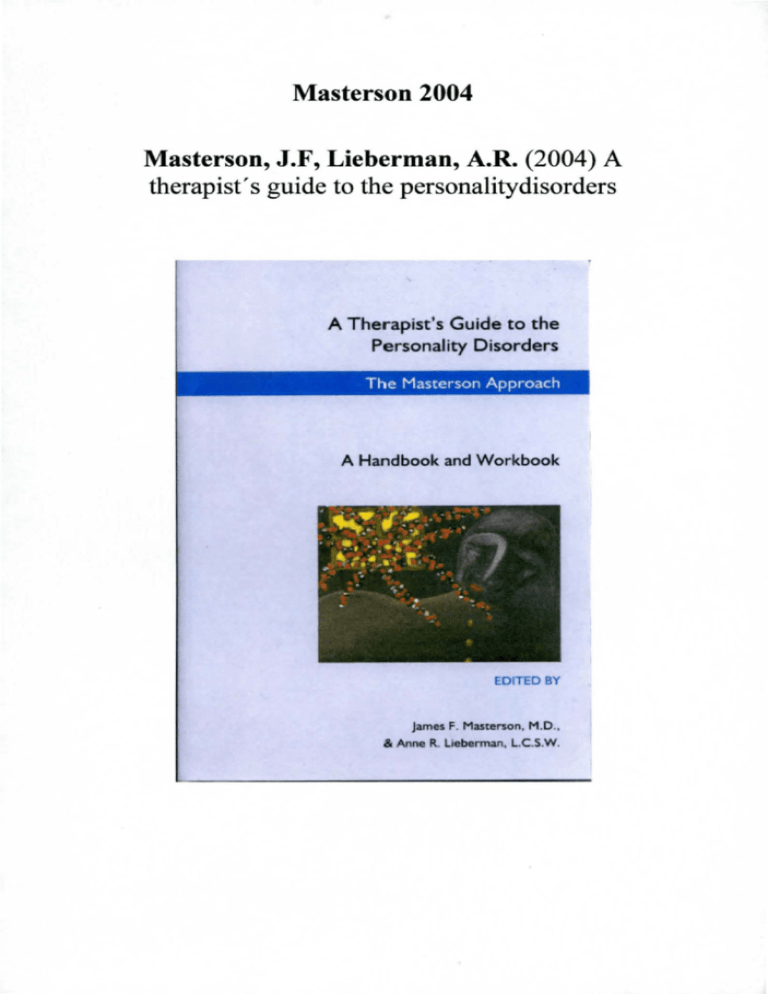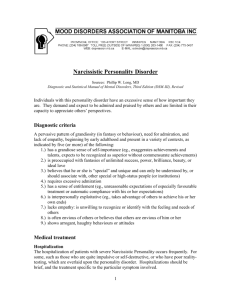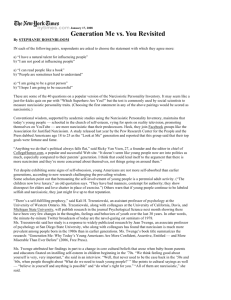Masterson 2004 Masterson, J.F, Lieberman, A.R. (2004) A
advertisement

Masterson 2004
Masterson, J.F, Lieberman, A.R. (2004) A
therapist's guide to the personalitydisorders
A Therapist's Guide to the
Personality Disorders
The Masterson Approach
A Handbook and Workbook
EDITED BY
James F. Masterson. M.D ..
& Anne R. Lieberman. L.C.S.W .
8
Masterson 2004, s.24
The term object relations refers to the internal representations of self and
others with associated affects, and how these structures then influence
relationships with one's self and with others. Because of failures in
development, a significant difference between people with personality
disorders and those without them is that people with personality
disorders do not have whole object relations. That is, their
internal representations of themselves and others are split into two partunits. Each part-unit has a very extreme, unrealistic, and one-sided view of
the self (the part self-representation) and a very extreme, unrealistic, onesided view of the other person (the part objectrepresentation).
Masterson 2004, s.26
NARCISSISTIC PERSONALITY DISORDER DIAGNOSIS CRITERIA
DSM-IV
A pervasive pattern of grandiosity (in fantasy or behavior), need for
admiration, and lack of empathy, beginning in early adulthood and
present in a variety of contexts, as indicated by five (or more) of the
following:
1. has a grandiose sense of self-importance (e.g., exaggerates achievements
and talents, expects to be recognized as superior without commensurate
achievements)
2. is preoccupied with fantasies of unlimited success, power, brilliance,
beauty, or ideal love
3. believes that he or she is special" and unique and can only be understood
by, or should associate with, other special or high-status people (or
institutions)
4. requires excessive admiration
5. has a sense of entitlement, i.e., unreasonable expectations or especially
favorable treatment or automatic compliance with his or her expectations
6. is interpersonally exploitative, i.e., takes advantage of others to achieve
his or her own ends
7. lacks empathy: is unwilling to recognize or identify wtih the feelings and
needs of others
8. is often envious of others or believes that others are envious of him or her
9
9. shows arrogant, haughty behaviors or attitudes
PUT OBJECT RELATIONS UNIT OF THI! NARCIS ISTlC PERSONALITY DISORDER
0.1.".
0
AO\l..... '''. Fl.I .cI PI'Hln it
Fund Part-Un
(In_qual.,
fragmented.
ut'lWOfWl)o •
uMn led.
f'~/OLO','SIt
9 Allo~
b.-.u ""lqUl!. Special. II'
d.red, !*Iac en eel
V;t(J{p-"tlifl~60'/
.1 {IlLSI<
?60'j ~Fw
t. admw.ct.
Lin
S?LV(Ff')
0 Alfec l
8b ndonmtnl d.p.........
'1\1
@p " ....0( on. - poor 'MUIY polDllpbOn: Imp<ll.oe con I:
11 tion lo\er1lnc.: ago bI>U darlee.
90 Del Ie M&_ 1m - spirt "G' .""IIII"e.: dIIIlll: aclll1g CKI . clinging, pro/KIlon; pro/edlva
Iden ft
on.
Masterson 2004, s.28
Another reason why individuals with personality disorders have difficulty
behaving in an adaptive and realistic way is that the ego is split into two
. parts: the reality ego and the pathological ego. This split is a result of an
interruption in development, and is in accord with Freud's belief
that, normally, the reality ego gradually develops from the pleasure ego.
This development occurs only partially in the patient with a personality
10
disorder, so that part of the ego continues to function in response to the
pleasure principle. This part of the ego is called the pathological ego.
The pathological ego strives to avoid the painful affects of
the abandonment depression. It supports the false self in denying reality
and acting out instead of facing painful conflicts and activating the real self.
The Difference Between Neurosis and Personality Disorder.
So many different things have been written about personality disorders that
sometimes "personality disorder" seems to be simply a new term for what
used to be called "neurosis." However, when one looks at the situation
through the lens of intrapsychic structure, it becomes very clear.
Individuals who have personality disorders have a split
Masterson 2004, s.29
intrapsychic structure; those with a neurosis do not. The major problems for
those with a neurosis develop after they already have successfully achieved
whole object relations. As the capacity for whole object relations is a
developmental achievement that usually occurs around the end of the
first three years of life and continues to be consolidated throughout
adolescence, this means that the problems we label "personality disorders"
began before age 3 and interfered with the nonnal consolidation of whole
object relations (Mahler, Pine, & Bergman, 1975).
Diagnosis by Intrapsychic Structure.
Diagnosing a Disorder of the Self is most effectively accomplished by
mapping out the patient's intrapsychic structure) as opposed to looking only
at behavior or symptoms (as the DSM-IV does, for example). People
may behave similarly or have similar symptoms, but still
~espond optimally to very different therapeutic approaches.
Masterson 2004, s.31
The Abandonment Depression
II
Those with Disorders of the Self remain largely unaware of how much they
are generalizing from past experiences with their parents. They have
developed a defensive system that is designed to protect them from
experiencing the painful feelings associated with their childhoods and with
the lack of support that they experienced for their developing real
selves. These underlying painful feelings make up the affects of
the abandonment depression. The abandonment depression includes such
difficult and painful feelings as suicidal depression, homicidal rage, panic,
shame, guilt, hopelessness, helplessness, loneliness, and emptiness.
Masterson 2004, s.42
The attributes delineated by the DSM's description of the Narcissistic
Disorder are pathological in an adult, but quite appropriate to a newly
mobile toddler engaged in what one developmental theorist called "a love
affair with the world." Full of a sense of just-won power, able to stand on his
or her own two feet and explore a universe alive with sound and color and
smell, the unquenchable delight and sense of grandiosity of this young
toddler stand in sharp contrast to the depression and anxiety of the older,
"terrible-two-ish" "rapprochement" child engaged in the work of
separation-individuation. This difference is directly traceable to the
fact that the younger "practicing" child is still in a state of intrapsychic
fusion with a perceivedly omnipotent maternal object.
Masterson 2004, s.43
Where the mother's pathology is such that she requires the child to resonate
to her own narcissistic projections, mirroring will be unempathic and
defective, leading to the preservation of unmodulated grandiosity as a way
of defending the underlying, unsupported empty and fragmented real self.
This libidinal unit of attachment is separated by the splitting defense from
the aggressive unit, which is composed of a part self-representation of being
12
humiliated, attacked, fragmented, and empty, fused with a part objectrepresentation that is harsh, attacking, critical, and punitive. The linking
affect of this empty/ aggressive unit is the abandonment depression.
However, whereas the Borderline patient's abandonment depression is
triggered by separation stress or attempts at individuative self-activation,
the Narcissistic patient's abandonment depression is precipitated either by
the pursuit of real self as opposed to narcissistic goals, or by the sense of
the object's failure to provide narcissistic supplies in the form of
idealizable omnipotence or perfect mirroring. The defensive response to
narcissistic injury and its consequences - abandonment depression,
narcissistic rage, and fragmentation - will be an attempt to reactivate the
grandiose/omnipotent unit by avoiding, denying, or devaluing the
offending object.
The Closet Narcissistic Disorder is so named because, unlike the
Exhibitionistic Narcissistic personality, the Closet Narcissistic patient's
goes underground. For whereas the Exhibitionistic Narcissistic patient's
false self is structured around the need to obtain maternal mirroring by
continuously living up to the mother's idealizing projections, the
individual with a Closet Narcissistic Disorder must continuously avoid the
mother's hostility, envy, and attack by mirroring the mother and denying
his or her
Masterson 2004, s.44
own grandiose wishes. Narcissistic supplies are then derived by basking in
the glow of the idealized other's reflected glory.
However, underlying the self-effacing [selv-utslettelse] fa(,:ade of the
Closet Narcissistic Disorder lies the pool ofinfantile grandiosity
that could not be made manifest, and was, therefore, never modulated. So,
despite their very different outward presentations, the Exhibitionistic and
Closet Narcissistic Disorders are but two sides of the same structural coin.
Masterson 2004, s.4S
13
The pervasive need to defend against internalized persecutory objects
leads to reliance on rigid pathological defenses that serve the purpose of
extruding and denying intolerable feeling. The ability to sustain activity in
the external world that ensures the more successful Narcissistic individual
some measure of supplies is, in these less capable patients, limited or
damaged, as the observing ego and tolerance of delay or disappointment
are easily breached, to be replaced by poor impulse control and a failure to
tolerate and master anxiety.
Instead, the intervention most suited to the intrapsychic world of the ,
Narcissistic patien t cons ists of what the Masterson Approach defines as
a Mirroring Interpretation of Narcissistic Vulnerability that addresses
the pain of the patient's real self in response to situations of narcissistic
injury, and the defense used to ward off that pain.
Masterson 2004, s.73
THE NARCISSISTIC PERSONALITY DISORDER
Anne R. Lieberman, L.C.S. W.
A certain amount of narcissism is a necessary component of a healthy
personality
Narcissism can be described as the libidinal investment in the self. Normal
narcissism is necessary to regulate self-esteem and to pursue interests and
ambitions. It is reality based; encompasses self-satisfaction experienced as
self-esteem, confidence, and a general sense of well-being; and
includes appropriate concern for others. Narcissism moves to
the pathological when it becomes self-centered, self-involved, lacking in
empathy.
This structure becomes pathological when it is fixed and chronic; repeats
itself over and over, independent of the external environment; is based on
fantasy; and defends against affect, rather than dealing with reality. It has
strengths and weaknesses, which serve both adaptive and maladaprive
purposes. Originally, it was not necessarily pathological; rather, it was the
child's response to developmental issues. At one time, the defenses served
a purpose. The problem is that they became fixed and rigid. In the
14
Narcissistic Personality Disorder, the intrapsychic structure of the
patient provides a sense of specialness and uniqueness by either
identification with or idealization of the object in order to ward off
underlying feelings of humiliation, shame, and fragmentation.
Masterson 2004. s.74
They seek treatment, as do all patients with a Disorder of the Self, to feel
better, not necessarily to get better.
... has difficulty tolerating ctifferences of opinion .
.. . he repeatedly loses jobs because he has difficulty with authority and
with acknowledging the opinions of others.
He can be charming and funny; he can also be controlling and critical.
... lying and secretiveness,
He did not understand why his wife was so angry or his colleagues and
bosses so intolerant and impossible, ...
Masterson 2004. s.75
These two people do not sound alike. One appears invested in himself, and
the other in the object. Yet, if we scratch the surface and look at the
intrapsychic structures, we see a very different picture.
I. DESCRIPTION
The Grandiose or Exhibitionistic Narcissistic Disorder: We are all
familiar with the picture of grandiosity. This is Harry. This is the individual
with a fa9ade of self-assurance, self-confidence, and self-preoccupation,
who constantly pursues admiration . Perfectionistic in striving for money,
power, and fame, he shows an extreme sense of entitlement, grows enraged
15
when criticized, and lacks empathy and concern for others in spite of
pursuing them to obtain their admiration and approval.
The surface adaptation and lack of anxiety and depression exhibited by
many patients with an Exhibitionistic Narcissistic Disorder can be
misleading; they often look pretty good and on the outside appear to be
functioning well. It is only when something in their world breaks down,
often in their jobs or their families, that we see what lies beneath the fayade.
The underlying feelings include intense envy, rage, feelings of
worthlessness and rejection, and a pervasive sense of impotence and
inadequacy.
The Closet Narcissistic Disorder: The person with a Closet Narcissistic
Disorder can be deceiving. He or she does not display
overtly exhibitionistic behavior, and may even present as humble, anxious,
inhibited, or shy. He or she may often first appear to be a person with a
Borderline Personality Disorder in his or her focus on the object. This is
so because the major emotional investment of the individual with a
Closet Narcissistic Disorder is in the omnipotent other rather than in the self.
The other is idealized and the patient's grandiosity is gratified. The patient
then "basks in the glow" of the object. These individuals do not have the
capacity consistently to maintain the continuity of defense of the
Grandiose Narcissistic patient, and are more prone to experiencing
envy and self-esteem impairment. They are also more likely to
be depressed. Kathy is a good example of a patient with a
Closet Narcissistic Disorder. She, as is frequently the case, first appeared to
have a more Borderline personality organization. It was only upon
examination of her underlying intrapsychic structure and her response to
intervention that the similarities with the more overtly Exhibitionist
Narcissistic personality became apparent.
The Devaluing Narcissistic Disorder: Most patients with a Narcissistic
Disorder of
Masterson 2004, s.76
the Self will fall into the above two categories, activating a grandiose self or
identifying with an omnipotent other. However, a smaller group
encompasses patients who are different, either projecting the underlying
16
impaired self onto the other and then acting out the role of the harsh
attacking object by devaluing anyone in their path, or by projecting
the harsh object and taking on the role of the impaired self. This is the
patient who will find fault with everything the therapist does, who is always
expecting, and finding, narcissistic injury.
II. DIFFERENTIAL DIAGNOSIS
To arrive at a differential diagnosis, seven factors must be considered
(Masterson & Klein, 1989, p. 9):
I. The presenting picture of the false, defensive self.
2. A review of current ego/self functions and impairments.
3. Developmental history.
4. Medical history.
5. Family history.
6. An assessment of intrapsychic structures.
7. The nature of the therapeutic relationship and response to interventions.
Once both psychosis and neurosis have been ruled out, it is necessary to
differentiate among the Disorders of the Self. The style of defense in the
person with a Narcissistic Personality Disorder differs from that of a
person with a Borderline Personality Disorder, where the self- and objectrepresentations are separate and split into two alternating part-units. The
Narcissistic patient's self- and object-representations are fused rather than
separate. The Borderline patient's projections of the rewarding
and withdrawing units are not so strong that reality can be totally denied,
devalued, or avoided.
The rage has a quality of coldness and lacks the relatedness of that of the
Borderline patient. The themes of power, perfection, and envy,
so prominent in the patient with a Narcissistic Personality Disorder, are
minimal in the Borderline patient, whose themes tend to be depression and
anger at the loss of wished-for supplies. The Narcissistic personality fears
fragmentation of self, whereas the Borderline personality fears loss of
the object.
17
Masterson 2004, s.77
The patient with a Narcissistic Personality Disorder pursues admiration,
perfection, and mirroring, whereas the primary goal of the Schizoid
patient is safety.
Further, the Exhibitionistic and Closet Narcissistic Disorders can be
differentiated from each other by the way in which the patient presents his or
her false self as either inflated (grandiose) or d~d (closet), , that is,
by whether the primary focus is on the self or on the object.
o ppr;,LtJ',i
r O'I"
Ip v~p«
III. DEVELOPMENTAL THEORY
One of the real problems with understanding the Narcissistic Personality
Disorder is the seeming paradox that a very primitive self/objectrepresentation is seen alongside what appears to be a high capacity for ego
functioning.
Typically, the Narcissistic patient, particularly the higher-level one, will
describe his or her childhood as good, with idealization of the parents.
However, three basic histories emerge.
I. Exhibitionistic: Parents use the child as an extension of their own
grandiosity. Expectations are projected onto the child, who feels adored,
admired, and loved in a way, through this projection. The mother is
always there to promote the child. The real self goes underground; the
child's grandiose self is being mirrored and stays out. Any appearance of
the real self is met with scorn, humiliation, derision, shame, cold
Masterson 2004, s.78
withdrawal, disapproval. In response, the idealized child will bring out parts
of the self that connect with the mother, developing into a fused, grandiose,
omnipotent unit. The child feels loved, but, in fact, was used. Upon closer
examination, the mother appears to have been cold and exploitative,
unable to acknowledge, confirm, or support her child's real self,
and instead, treats the child as an extension of her own frustrated needs.
The child's preoccupation with maintaining the mother's idealization
18
preserves the grandiose self and helps to avoid awareness of the real self
and of the motber's empatbic failures and depersonification of ber cbild .
... described her as a dependent, fearful, symbiotic, but not nurturing,
woman who lived for ber son and made him the center of ber life.
2. Closet: In the second case, there are two possible scenarios. One, the child
comes up against subtle or not-so-subtle scorn, derision, and bumiliation for
expressing ber real self. She has memories of being attacked, devalued, and
disparaged as a cbild. She learned not to get rid of the grandiosity, but to
put it into hiding. She connected with the parent by downplaying her self,
by excessive modesty. She is constantly scanning the environment for
evidence of the bostile depreciation by the other. Or, two, the parent
communicates to the child that/ if the cbild reveres tbe parent, the child
will be loved, adored, and tended to. In either case, the probable outcome is
a
vi s/< ,:\..;r
Closet Narcissistic Personality Disorder, where the cbild idealizes tbe
parent and effaces tbe self. This person is more prone to narcissistic
vulnerability and injury, and is more aware of the impaired self (Fischer,
in Masterson & Klein, 1989, p. 70), and can often first appear to have a
Borderline personality structure.
Masterson 2004, s.79
She described her fatber as ineffectual, sweet, often depressed, never very
successful, and somewhat lost. Her mother worked on an assembly line, but
would go to work every day dressed in a suit and white gloves. She
was experienced as a critical, narcissistic woman whose constantly repeated
message to Kathy had been to protect her from any information or emotion
that might upset her. Kathy said that her motber loved her best when sbe
was "seen and not beard," but was a good student whose performance
reflected well on her parents. She stated that she forever falls short of
her mother's (and her own) need for perfection, and repeatedly expressed
her sense of her own inadequacy about her ability to function in an
autonomous position. She has a paralyzing fear of being a
disappointment in her own eyes and those of the other, and demonstrated
an inability to observe and take credit for her many accomplishments,
saying, "If I can't see myself reflected positively in the eyes of the other
person, I have no self,"
19
3. Devaluing: Derision moves into intimidation, violence, violation, abuse,
a consistent threat against expressing real or grandiose needs. This kind of
treatment can result in a low-level Devaluing Narcissistic Disorder. There
is no grandiosity of the self or idealization of the other, but the child lives
in a state of siege, with paranoid, Schizoid defenses.
the DSM-IV, which presents a purely descriptive, external portrayal of
the Narcissistic Personality Disorder, the Masterson Approach utilizes an
understanding of the internal intrapsychic structure ofthe patient.
The person with a Narcissistic personality organization has a fused object
relations unit (see chart on page 80), which differs markedly from the split
object relations unit of the Borderline patient. In the Narcissistic
Personality Disorder, this part of the intrapsychic structure has been
designated the "grandiose seif-omnipotent other." The outward,
defensive unit is that of a grandiose self-object, which is superior
and elite, with an affect of being perfect, special, or unique.
The omnipotent object is perfect and powerful, and necessary
for idealization and mirroring.
Masterson 2004. s.80
The Closet Narcissistic patient projects the omnipotent object, and
idealizes the perfection of the object, which he or she expects to share,
that is, the patient basks [sole segJ in the glow of the object.
The linking affect in both cases is one of being unique, great, wonderful,
special, promising, adored, perfect, entitled.
What is well hidden beneath this grandiose self-omnipotent object
structure is the aggressive or empty object relations unit, which is the
other fused self/objectrepresentation. It consists of an object that is
harsh, punitive, and attacking and a selfrepresentation that is
humiliated, shamed, and empty, linked by the affects of the abandonment
depression, which are different from those of the Borderline individual.
With the Narcissistic personality, the abandonment depression
is experienced as shame, humiliation, narcissistic injury, a colder
20
sense of outrage, and a lack of relatedness. The resulting
extreme sensitivity to feeling criticized or attacked forces the
Masterson 2004, s.81
therapist to rely on therapeutic interventions other than confrontation,
primarily mirroring interpretations of narcissistic vulnerability (Fischer,
in Masterson & Klein, 1995, p. 70).
Because the affects of the abandonment depression are so devastating, they
are immediately defended against by externalizing tbe depression and
projecting its object-representation as causing the depression. In other
words, the problem is out tbere; it is what otbers are doing to the patient
that is so upsetting. The patient then proceeds to avoid, deny, and/or
devalue tbe offending otber, thereby restoring tbe balance of his or
her narcissistic equilibrium and avoiding tbe experience of depression.
The relatively free access to aggression enables the person with a
Narcissistic Personality Disorder either aggressively to coerce [tvinge] the
environment into resonating with his or her narcissistic projections, or, if
this fails, to deal with that failure by projection, avoidance, denial, and
devaluation (Masterson, 1981, p. 16). In order to protect this illusion of
omnipotence and invulnerability, the patient will deny, devalue,
dismiss, witbdraw from, or rationalize any stimuli that challenge
this omnipotence and invulnerability.
Therefore, in order to keep his grandiosity intact and the underlying
depression at bay, Harry's explanations for his lost jobs and marital
problems were that his superiors were basically jerks who did not appreciate
his suggestions and ideas, while his wife simply misunderstood him, could
not see the wisdom of his choices, and was unsupportive.
The intrapsycbic structure of the child is formed in response to
developmental stressors that result from a combination of nature, nurture,
and fate. Nature refers to the genetic endowment of the infant, whereas
nurture reflects the maternal capacity to support the emerging self.
When the sense of self of the Narcissistic patient has been so severely
injured because of ruptures in any or all of these, a child will:
21
1. Dismiss the real self, and try to recapture the narcissistic relationship by
becoming grandiose.
2. Push the real self underground, idealize the object, and try to comply
(Closet).
Masterson 2004, s.82
3. Or feel under siege, in danger of disintegration or fragmentation if the
object was
so narcissistically injurious. The child will give up on being mirrored by,
or idealizing, the mother. There is a strong development of the aggressiveempty unit that is projected externally, in order to protect the self against
the perception that the other is harsh and attacking (Devaluing).
The resulting impairments in ego functioning will include poor reality
testing, poor impulse control, poor frustration tolerance, poor ego
boundaries, and the use of aggression to manipulate the external world to
get narcissistic supplies. The ego defense mechanisms that will be most
prominent are splitting, avoidance, denial, acting out, clinging,
projection, projective identification, idealization, externalization,
devaluation, and omnipotence.
For the person with a Narcissistic Personality Disorder, self-esteem and
selfworth are externally derived. These patients tend to do better earlier in
life than later, when losses and demands for intimacy and to give are
much stronger. Aging is the ultimate narcissistic wound.
v. TREATMENT
The Narcissistic patient enters treatment with a focus on defense rather
than on internal contl ict and painful affect.
The main therapeutic challenge when working with the Narcissistic
patient becomes finding a way to enter the patient's system to effect
therapeutic change without precipitating a defensive reaction.
22
With the Borderline patient, the focus is on confrontation of defense.
Confrontation ofthe Narcissistic patient, however, will be experienced as
an attack on the grandiose self, resulting in a real sense of narcissistic
injury and necessitating a tightening of defense.
Narcissistic patients will avoid pain by avoiding exposure of their real
selves, seeking instead something that feels better, either fusion
Masterson 2004. s.83
with or idealization of the object.
ill the case of the Closet Narcissistic patient, the focus should be on the
failures in the idealized object.
The mirroring interpretation of narcissistic vulnerability consists of
three parts, which can be remembered by the phrase "pain, self, defense."
Broken down, each component of the intervention is as follows:
I. PAIN: IdentifY and acknowledge the painful affect the patient's self is
feeling.
This is the mirror that demonstrates to the patient that you understand and
empathize with what he or she is expressing, and makes it possible for you
then to add:
2. SELF: Emphasize the impact on the patient's self in such a way as to
indicate
your understanding of the patient's experience.
3. DEFENSE: identifY and address the defense or resistance, which can
then be
Masterson 2004. s.84
tied to the first part by observing how it protects) defends) calms, and
soothes the patient from the experience of the painful affect. It is important
23
to point out the function of the defense with great care in order to avoid
precipitating a narcissistic injury. Keep in mind that the patient's action
arose from a need to maintain his or her self-esteem or sense of selfcohesion [sammenhengJ" .
Should they touch on a subject that brings up painful affect, they will
change the topic to one that moves them away from feeling by reinstating
the defense.
When an intervention abruptly disrupts the sense of merger, the patient will
feel narcissisticaUy wounded, criticized, misunderstood, and
badly treated. In that case, the patient will often leave therapy prematurely
and abruptly.
Masterson 2004. s.85
The Closet Narcissistic Disorder
Unlike the Exhibitionistic patient, the less obvious Closet Narcissistic
patient's transference acting out will take the form offocusing on the object
instead of on his or her own painful feelings. Often this type of defense can
be mistaken for the clinging of the Borderline Personality Disorder, and
can only be differentiated by understanding the function of the defense.
Understanding the patient's need for idealization made it much harder to
buy into her projections!
Masterson 2004. s.86
"ft's really difficult for you to talk about yourself (pain), which leaves you
feeling exposed and vulnerable (self). To protect yourself, you try to get
me talking, and then maybe we can stay away from that painful
stuff' (defense).
"Being at that party was really so painful for you because so many of
the people there seemed to have so much of what you'd like for yourself
24
(pain). When you're with them, all you can think about is what you don't
have. Eventually, this causes you to feel terrible about yourself, as though
there is something wrong with you (self). So, to soothe these feelings, you
put the group down and tell yourself that they're not worth it, that you can
find better friends (defense). The problem is that you can't seem to find a
place for yourself."
The risk is that as soon as the patient experiences the therapist as of value,
this will evoke dependency feelings that will lead the patient to feeling
envy, shame, humiliation, which he or she will then try to control by
moving away from treatment.
For a Closet Narcissist, the emphasis is on interpreting the patient's need to
focus on the object.
Masterson 2004. s.87
Understanding the Disorders of the Self Triad is as crucial in working with
patients with a Narcissistic Personality Disorder as it is with the other
personality disorders. Briefly, what this means is that self-activation leads to
anxiety and abandonment depression, which leads to defense
Typically, this takes the form of reinflating the grandiose self, or
remobilizing the omnipotent object.
After repeated cycles through the triad, the patient gradually becomes more
aware of his or her real self and how it differs from the false, defensive self.
Masterson 2004. s.88
Real intimacy is possible because the patient can experience others as
separate individuals with their own separate centers of initiative, ...
The basic goal of shorter-term treatment is to improve the patient's
adaptation to reality.
25
Although once-a-week therapy is not enough to allow for a restructuring of
the personality, it is enough for the patient to make significant gains in
insight and functioning.
Many of these patients come to therapy having no idea why they
so frequently feel awful.
Masterson 2004. s.79
Working with Narcissistic patients can arouse intense countertransference
feelings in the therapist.
Masterson 2004. s.142
28. The Closet Narcissistic Personality Disorder can be differentiated
from the Exhibitionistic Narcissistic Personality Disorder by:
a. A fear of being appropriated [Iagt beslag pal by the other or of being
alone in the universe.
b. A projection of the rewarding or withdrawing units.
c. A false self that is grandiose or deflated. with primary focus on the self
or on the object.
d. The profession chosen by the patient.









